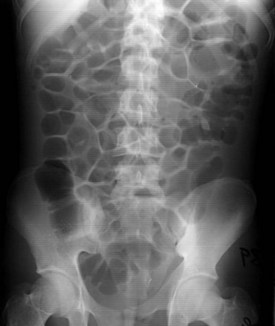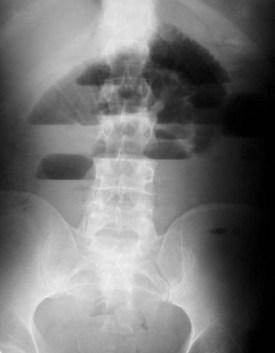24 Ileus
Ileus is defined as disruption of coordinated physiologic bowel motility owing to a nonmechanical cause.1 As a result, intestinal contents cannot progress through the gastrointestinal (GI) tract. The word ileus is derived from the Greek eileos, which means “twisting.” An ileus can develop as a primary process or as a result of a separate process that is usually associated with inflammation. The diagnosis of ileus must be differentiated from the diagnosis of mechanical bowel obstruction, since the latter condition also blocks the normal aboral progression of bowel contents but is due to the presence of an extrinsic or intrinsic anatomic barrier. These two conditions are treated differently.
 Clinical Features and Diagnosis
Clinical Features and Diagnosis
Radiographic studies are often obtained during the evaluation of patients with suspected ileus. Abdominal radiographs sometimes can be helpful for differentiating ileus from mechanical small bowel obstruction. The presence of gas in the stomach, small intestine, and colon (Figure 24-1) suggests ileus. In contrast, a paucity of gas within the abdomen, air/fluid levels within the small bowel, and absence of air within the colon suggest mechanical small bowel obstruction (Figure 24-2). A computed tomography (CT) scan with enteral contrast administration can better distinguish patients with ileus from those with mechanical bowel obstruction. Inspection of the abdominal CT scan often makes it possible to accurately localize a point of obstruction or a region of transition from dilated to decompressed bowel. If these findings are present, the diagnosis of mechanical bowel obstruction is established. Passage of oral contrast into the colon within 4 hours favors ileus over a bowel obstruction as the cause of intestinal dysmotility. The CT scan can also identify other intraabdominal inflammatory processes that can be the cause of ileus (e.g., appendicitis, pancreatitis, intraabdominal abscess).
 Treatment and Outcome
Treatment and Outcome
Nasogastric (NG) tube decompression is reserved for patients with abdominal distension, nausea, or vomiting. Several randomized clinical trials have shown that NG decompression does not shorten the duration of ileus in postoperative patients.2 Moreover, presence of an NG tube can contribute to respiratory complications such as atelectasis and pneumonia.
Nonsteroidal antiinflammatory agents (NSAIDs) should be used for pain control where appropriate; NSAIDs have been shown to reduce postoperative nausea and vomiting as well as improve GI transit in several experimental and clinical studies.3 NSAIDs not only reduce the need for high doses of narcotics but also can decrease inflammation in the intestinal wall.
A midthoracic epidural catheter should be considered for patients who are undergoing abdominal procedures. The level of the epidural catheter is important because low thoracic and lumbar catheters are less effective. Epidural administration of local anesthetics can reduce the incidence and degree of ileus by blocking afferent as well as efferent inhibitory reflexes, including inhibitory sympathetic efferent signals.4 Total parenteral nutrition (TPN) should be considered when the duration of ileus exceeds 5 days, particularly for patients who are malnourished.
Most pharmacologic promotility agents that have been tested to hasten the resolution of ileus are ineffective. Metoclopramide hydrochloride (Reglan), the most frequently used prokinetic agent, is a cholinergic agonist and dopamine antagonist. A number of randomized trials of metoclopramide have failed to demonstrate significant reduction of the duration of postoperative ileus.5
More recently, the mu opioid receptor antagonists, alvimopan6 and methylnaltrexone,7 have been evaluated in phase III randomized, controlled clinical trials. Because these agents do not cross the blood-brain barrier, they do not interrupt the analgesic effects of narcotics. Unfortunately, results from studies of these newer agents have been mixed, and the trial designs used to evaluate them were less than optimal; neither are routinely used in clinical practice. Erythromycin is another prokinetic agent that binds to and stimulates the motilin receptor on small-intestinal smooth muscle cells. Two randomized trials examined the effects of erythromycin on the duration of postoperative ileus, and neither demonstrated a beneficial effect.8
Prasad M, Matthews JB. Deflating postoperative ileus. Gastroenterology. 1999;117(2):489-492.
Nelson R Nelson R, Edwards S, Tse B. Prophylactic nasogastric decompression after abdominal surgery. Cochrane Database Syst Rev 2007(3):CD004929.
Ferraz AA, Cowles VE, Condon RE, et al. Nonopioid analgesics shorten the duration of postoperative ileus. Am Surg. 1995;61(12):1079-1083.
Liu SS, Wu CL. Effect of postoperative analgesia on major postoperative complications: a systematic update of the evidence. Anesth Analg. 2007;104(3):689-702.
Jepsen S, Klaerke A, Nielsen PH, Simonsen O. Negative effect of metoclopramide in postoperative adynamic ileus. A prospective, randomized, double blind study. Br J Surg. 1986;73(4):290-291.
Traut U Traut U, Brugger L, Kunz R, et al. Systemic prokinetic pharmacologic treatment for postoperative adynamic ileus following abdominal surgery in adults. Cochrane Database Syst Rev 2008(1):CD004930.
Neyens R, Jackson KC2nd. Novel opioid antagonists for opioid-induced bowel dysfunction and postoperative ileus. J Pain Palliat Care Pharmacother. 2007;21(2):27-33.
Smith AJ, Nissan A, Lanouette NM, et al. Prokinetic effect of erythromycin after colorectal surgery: randomized, placebo-controlled, double-blind study. Dis Colon Rectum. 2000;43(3):333-337.
1 Prasad M, Matthews JB. Deflating postoperative ileus. Gastroenterology. 1999;117(2):489-492.
2 Nelson R, Edwards S, Tse B. Prophylactic nasogastric decompression after abdominal surgery. Cochrane Database Syst Rev 2007;3:CD004929.
3 Ferraz AA, Cowles VE, Condon RE, et al. Nonopioid analgesics shorten the duration of postoperative ileus. Am Surg. 1995;61(12):1079-1083.
4 Liu SS, Wu CL. Effect of postoperative analgesia on major postoperative complications: a systematic update of the evidence. Anesth Analg. 2007;104(3):689-702.
5 Jepsen S, Klaerke A, Nielsen PH, Simonsen O. Negative effect of metoclopramide in postoperative adynamic ileus. A prospective, randomized, double blind study. Br J Surg. 1986;73(4):290-291.
6 Traut U, Brugger L, Kunz R, et al. Systemic prokinetic pharmacologic treatment for postoperative adynamic ileus following abdominal surgery in adults. Cochrane Database Syst Rev 2008;1:CD004930.
7 Neyens R, Jackson KC2nd. Novel opioid antagonists for opioid-induced bowel dysfunction and postoperative ileus. J Pain Palliat Care Pharmacother. 2007;21(2):27-33.
8 Smith AJ, Nissan A, Lanouette NM, et al. Prokinetic effect of erythromycin after colorectal surgery: randomized, placebo-controlled, double-blind study. Dis Colon Rectum. 2000;43(3):333-337.



